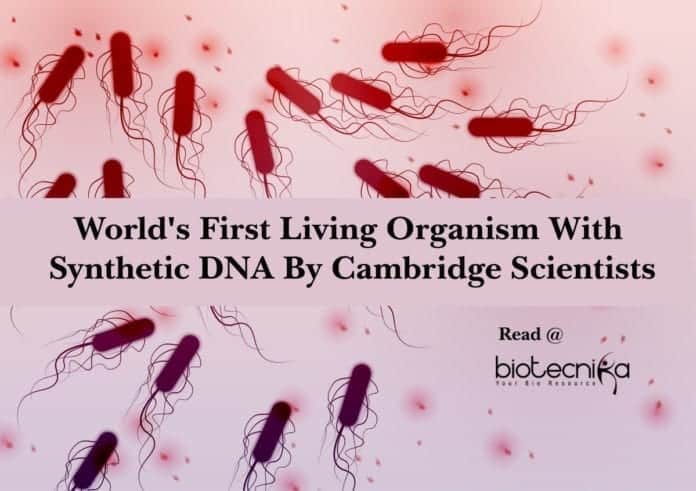World’s First Living Organism With Synthetic DNA By Cambridge Scientists
Cambridge University Researchers have created the World’s First Living Organism With synthetic – redesigned DNA – a living organism that is made up of completely synthetic altered DNA.
Over a period of 2 years, Cambridge scientists in the molecular lab have read & redesigned the DNA of Escherichia coli (E.coli) before creating a synthetic version of its DNA. E.coli is generally found in human gut & soil and is similar to its similar species but can thrive on a smaller set of genetic instructions.
E.coli’s existence is proof of the concept that life can exist with a restricted genetic code, thus opening possibilities to create organisms whose biological machinery can be replicated to test drugs, virus resistance & has several other biological & medical applications.
The artificial genome created comprises of 4m base pairs. Upon printing the genetic code letter in full on A4 sheets, it runs to 970 pages, making the genome the largest by far that scientists have ever built.
As per Jason Chin – an expert in synthetic biology who lead the project, initially it was totally unclear whether it was possible to construct an artificial genome this large.
In a living
cell, DNA exists in a coiled form and carries the instructions needed for a cell to function. For example, when a cell in need of more protein, it reads the DNA that – activate the codons that encode the right protein.The synthetic genome replica of E.coli was created by removing some of its superfluous codons. Upon analysis of the genetic makeup if the E.coli DNA, whenever they encountered TCG – that makes amino acid called serine – they wrote it as AGC instead which performs the same function, thus replacing the two codons keeping its functions intact.
After edit of over 18,000, the researchers had removed every occurrence of the three codons from the bug’s genome. The reconstructed genetic code was then chemically synthesized and was added into E.coli piece by piece, replacing the organisms natural genome. And there they were- with an organism that had completely synthetic DNA.
The organism is named as Syn61, and is a little longer than the naturally occurring E.coli. Though it grows slowly, it does survises.
This first of its kind designer life form will open doors for much more experimentation in the field of synthetic biology. Since their DNA makeup is different, upon invasion by a virus it will struggle hard to spread inside the organism – thus making it virus resistant. The results could be game-changing. Currently, E.coli is already in use by biopharmaceutical industries to manufacture insulin and other medicinal compounds for diseases like cancer, multiple sclerosis, heart attacks, and various eye disease. But a major challenged faced is when the bacterial cultures get contaminated with a virus or other pathogenic microbes. Such newly created organisms with synthetic repurposed genome can be used to curb such situations.
In the future, genetic codes can also be repurposed to create designer enzymes, proteins, and drugs.
Way back in 2010, US of A scientists declared the creation of what is today known as the 1st Synthetic genome Organism. It is now known that the bug Mycoplasma mycoides has a minuter genome than E Coli – roughly 1m base pairs & is not properly redesigned.
Clyde Hutchison, A researcher from a United States Lab comments that this scale of genome replacement is larger than any complete replacement published so far.
Another Synthetic Biology expert from Imperial College London states that this research has taken the field of the synthetic genome to a much much higher level than earlier anticipated but now has also made the most coding changes to the genome till date.
However, it is to be noted that this world record may not stand for a long period of time. Ellis and his research group are now trying to build a synthetic genome for baker’s yeast. In the meantime, it is reported that Harvard technologists are now all set to produce bacterial genomes with much complex coding changes. It is expected that the changed E Coli will not grow on a similar scale as its natural counterparts.
Researcher Ellis adds that it can be challenging as well as surprising to see something grow after so many genomic modifications.
This article has been adapted from the original content posted at the Guardian.































Informative article.